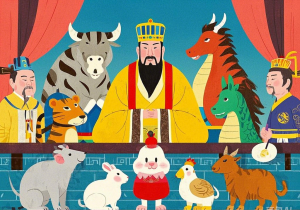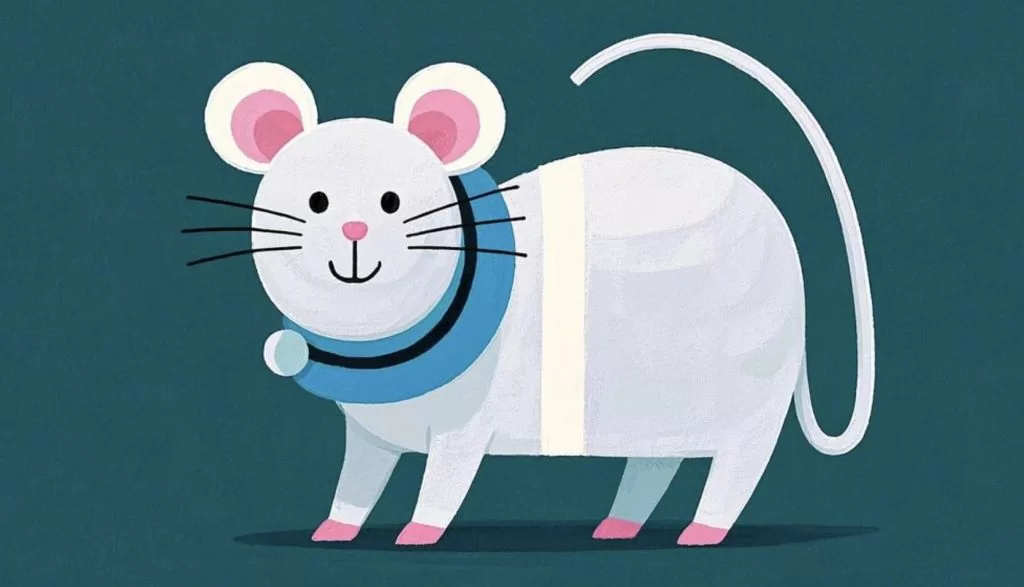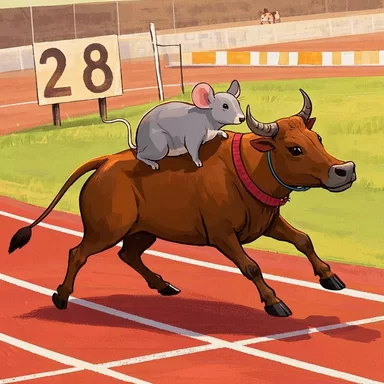Forbidden Secrets of the Rat: Decoding the Zodiac’s Wise Guardian & Ancient Rituals
- Basic Introduction
- Historical Origin
- Symbolic Meanings
- Cultural Connotations and Customs
- Stories Related to Rats
- Personification of the Rat Image
- Famous People Born in the Year of the Rat
- Years
The Rat is one of the twelve Chinese zodiac signs and represents the first of the twelve Earthly Branches. Rats are small, agile, and adaptable. They are most daring and active during the period of Zi (midnight to 1 am).
Chinese Name: 鼠
Other Name: 子鼠
Rank in the Chinese Zodiac: First
Pinyin: shǔ

Basic Introduction
The character “鼠” is pronounced “shǔ”.
In a fable by Liu Zongyuan, a Tang Dynasty writer, a person born in the year of the Rat believed that “Rats are the gods of the Zi period, so I love rats.” There is a similar example in Anecdotes of the Qing Dynasty: “In Yancheng, there was a man surnamed He. Because he thought his Chinese zodiac sign was the Rat, he didn’t keep cats and always stopped others from catching rats. As time passed, the rats multiplied greatly and jumped around fearlessly in and out of the house.”
People born in the year of the Rat were born in 1924, 1936, 1948, 1960, 1972, 1984, 1996, 2008, 2020, etc.

Historical Origin
Legend has it that one day, the Jade Emperor wanted to rank the twelve Chinese zodiac signs. He initially selected the Ox, Tiger, Rabbit, Dragon, Snake, Horse, Sheep, Monkey, Rooster, Dog, Pig, and Cat, and asked them to come for the ranking the next day. At that time, the Cat and the Rat were good friends. The Cat asked the Rat to wake it up early the next day because it was one of the candidates for the zodiac signs and wanted to go to heaven to be ranked. The Rat readily agreed.
The next day, the Rat woke up early but didn’t wake the Cat. Instead, it went to heaven alone. When it was time to rank the zodiac signs, the Jade Emperor arranged them in the order of Ox, Tiger, Rabbit, Dragon, Snake, Horse, Sheep, Monkey, Rooster, Dog, Pig, and Cat. When the Jade Emperor asked if the animals had any objections, only the Rat raised an objection: “I don’t think the Cat should be selected. It doesn’t respect you at all. Look, it’s still sleeping and doesn’t take the zodiac ranking seriously.” The Jade Emperor saw that the Cat was indeed sleeping. He flew into a rage and decided that the Cat would never be allowed to go to heaven again. At the same time, he let the Rat take the Cat’s place. Then the Rat said, “I must be ranked first!” “Why? Is your contribution greater than that of the Ox?” “People think I’m much bigger than the Ox.” The Jade Emperor had no choice but to let people judge. People who came from the mortal world to the cloud said, “Wow! What a big Ox!” Then, when they saw the Rat standing on the Ox’s head, they all said, “What a big Rat! It’s even bigger than the Ox!” So the Jade Emperor had to rank the Rat first.
There are mainly three reasons why the Rat ranks first in the Chinese zodiac:
Firstly, it is due to the folk legend about the ranking of the zodiac signs. According to Han ethnic folk stories, when the Yellow Emperor wanted to select twelve animals as palace guards, the Cat asked the Rat to register for it, but the Rat forgot. As a result, the Cat wasn’t selected, and since then, they became enemies. The Elephant also came to participate in the competition, but the Rat got into its nose and drove it away. The other animals originally recommended the Ox to be the first, but the Rat jumped onto the Ox’s back, and the Pig joined in the起哄. So the Rat ranked first and the Pig ranked last. The Tiger and the Dragon were not convinced and were later named the King of the Mountains and the King of the Seas, ranking after the Rat and the Ox. The Rabbit was also not convinced and raced with the Dragon, and finally ranked ahead of the Dragon. The Dog was indignant and bit the Rabbit, so it was punished and ranked second from the last. The Snake, Horse, Sheep, Monkey, and Rooster also went through competitions and were ranked one by one, finally forming the order of Rat, Ox, Tiger, Rabbit, Dragon, Snake, Horse, Sheep, Monkey, Rooster, Dog, and Pig. Although these legend stories are not scientific explanations, they reflect people’s desire to explain the selection of the twelve Chinese zodiac signs.
Secondly, ancient Chinese scholars explained the relationship between the Earthly Branches and the zodiac animals from the perspective of the twelve two – hour periods of the day and night. In the dark and chaotic world, the Rat comes out to move around near midnight and bites through the chaos between heaven and earth, which is called “the Rat bites open the sky”. Therefore, the Zi period corresponds to the Rat.
Thirdly, according to the Chinese concept of Yin and Yang, the twelve animals are divided into Yin and Yang categories. The Yin and Yang of animals are determined by the odd or even number of their toes. Generally, the number of toes on the front and back feet of animals is the same, but the Rat has four toes on its front feet and five toes on its back feet, with both odd and even numbers on the same body. Since things that are rare are precious, the Rat is ranked first.

Symbolic Meanings
The first symbolic meaning of the Rat is spirituality, which includes its cleverness and the ability to be psychic.
Rats have a sensitive sense of smell, are timid and suspicious, and have a high level of vigilance. In addition, their bodies are very agile. They can run quickly through walls and across roofs. They also have two other remarkable abilities: they can fall from a height of tens or even hundreds of meters without getting seriously injured. After landing, they can quickly get up and go about their business as usual. Although they are not aquatic animals and don’t have excellent swimming skills, they can swim through narrow ditches, shallow waters, and ponds. In order to survive, they can even swim several meters underwater without getting hurt.
So it’s really hard to kill a rat by drowning or dropping it from a height. People often use the phrase “as shrewd as a rat” to describe someone’s shrewdness and cleverness. The cleverness of the rat has become a standard for comparison. Just as people would say “better than a Mercedes – Benz” to describe an excellent car, rather than “better than a Volga”. Similarly, when we describe a person as being quick in action and adaptable, we often say that he is “as changeable as a rat”. Folk people also believe that rats are psychic and can predict good and bad luck, as well as disasters.
In fact, rats live in nature. It’s normal for them to react to natural disasters such as earthquakes, floods, droughts, and locust plagues. This is a special instinct of living things on Earth. It’s just that due to the limitations of human knowledge, we haven’t been able to uncover its mystery and laws. Before the Tangshan earthquake, people were surprised to find rat groups fleeing to the outskirts or huddling together in relatively open places such as roads and streets. They didn’t understand what these signs implied. Similar things must have happened many times in ancient times. So rats became psychic creatures in people’s minds. We can get a glimpse of this from the interpretations of dreams about rats in Zhou Gong’s Dream Interpretations.
The second symbolic meaning of the Rat is its strong vitality.
One aspect is its strong reproductive ability and high survival rate. For example, a female rat can give birth to 5 to 10 baby rats per litter in a natural state, and the maximum can be 24. The gestation period is only 21 days, and the female rat can become pregnant again on the day of giving birth. The baby rats can reach sexual maturity after 30 – 40 days, and the female ones will join the ranks of reproducing offspring. In this way, a female rat can give birth to about 5000 offspring in a year. As for the grandchildren and great – grandchildren, the number is too large to count. According to research, there is a unique chemical substance in the body of female rats that can make male rats fall in love with them. This is probably one of the reasons why rats are good at reproducing. Therefore, in folk, a woman as a “rat’s womb” or “rat’s belly”, which means she has a strong reproductive ability.
Rats have a high survival rate and a long lifespan. If they are not attacked by natural enemies such as cats or subject to large – scale extermination by humans, most rats can live a long life and die a natural death with numerous descendants. This is something that other animals can only envy.

Cultural Connotations and Customs
Stories Related to Rats
There was once a “Rat’s Wedding Day” festival. Generally, it was on the 25th day of the first lunar month. On that night, every household would turn off the lights. The whole family would sit on the kang in the main hall, eating food like “rat claws” made of flour in silence. They kept quiet to facilitate the rat’s wedding and avoid offending the rats, so as not to bring bad luck in the coming year. In Taiwan, people consider the 3rd day of the first lunar month as a minor New Year’s Day. It is said that the night of the 3rd day is the wedding day of rats. The folk paper – cut “The Rat’s Wedding” reflects this belief. So people don’t turn on the lights late at night, sprinkle rice and salt on the ground, and go to bed early to avoid disturbing the rats’ happy event.
In the old days, there was a custom of avoiding “rat falling” in Shanghai and its surrounding areas. When a rat fell while going out to look for food, it was called “rat falling”. It was said that those who saw it would have bad luck, either getting sick or even dying. People had to perform a ritual to resolve it. The method was to beg for white rice from door to door, which was called “hundred – family rice”. After bringing it home and cooking it, they believed they could resolve the bad luck.
In the Jianghan Plain area of Hubei, the night of the Xiaochu (the beginning of a period) was regarded as the Rat’s Wedding Day, commonly known as “rat adding to the dowry”. On that day, every household had to put flower – inserted pancakes in a dark place, prohibit pounding rice and grinding flour, and both adults and children were not allowed to make noise. If they disturbed the rats, it was believed that the rats would cause trouble in the coming year.
In some areas of Qinghai, there is a custom of “steaming blind rats”. Every year on the 14th day of the first lunar month, every household makes twelve rats out of dough without pinching their eyes, and then steams them in a steamer. On the Lantern Festival, they are placed on the offering table, with lamps lit and incense burned, praying that the rats will only eat grass roots and not damage the crops, so as to ensure a good harvest in that year.
On the first Zi day of the first lunar month, the Korean ethnic group holds a folk activity of burning rat fires. The children of farmers spread straw on the ridges of the fields and light it to burn weeds and drive away field rats. This folk activity is beneficial for killing rats and insects, and the plant ash can also fertilize the fields. In addition, since the Zi day corresponds to the Rat, lighting a rat – burning fire on this day gives people psychological satisfaction.
Personification of the Rat Image
In China, the rat is regarded as the embodiment of chivalry. In the classic masterpiece The Three Heroes and Five Gallants, there are five heroes named after rats: Lu Fang, the Sky – Piercing Rat; Han Zhang, the Earth – Penetrating Rat; Xu Qing, the Mountain – Piercing Rat; Jiang Ping, the River – Turning Rat; and Bai Yutang, the Brocade – Furred Rat.
A few years ago, in a church in Austria, people found a painting of an animal that resembled a rat on the mural. Its image was surprisingly similar to “Mickey Mouse”. It is said that this mural has a history of more than 700 years. This shows that humans not only humanized rats very early, but also deified them. Whether the “Mickey Mouse” image in the American Disneyland originated from here has become a question for people. An artist even jokingly said that the figure next to the holy image in the mural of the Austrian church is exactly the protagonist depicted in American cartoons, “Mickey Mouse”.
Famous People Born in the Year of the Rat
Galileo Galilei, Zheng Chenggong (Zheng Sen), Wei Zheng (Wei Zheng), Shangguan Wan’er, Du Fu, Bai Juyi, Zhu Di, Qi Jiguang, William Shakespeare, Gong Zizhen, Leo Tolstoy, Zhang Wentian, Li Fuchun, Wang Li, Xia Yan, Nie Er, Wu Jianxiong, Liu Shaotang, Percy Bysshe Shelley, Liu Yanjun, He Fenbo
Years
The Chinese zodiac “Year of the Rat” (鼠年) corresponds to years with the Chinese zodiac sign “子” (zǐ), occurring every 12 years. The years include:
2044, 2032, 2020, 2008, 1996, 1984, 1972, 1960, 1948, 1936, 1924, etc.
How to Determine Rat Years: A year is a Rat year if the remainder when divided by 12 is 4 (e.g., 2020 ÷ 12 = 168)


